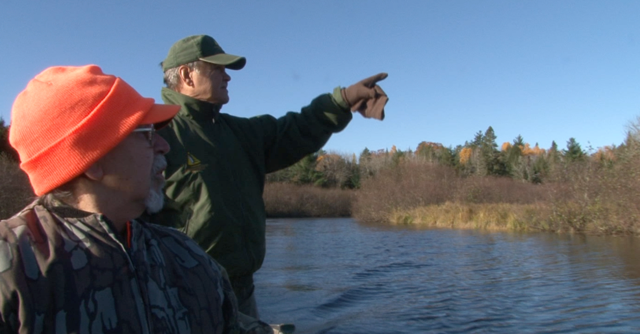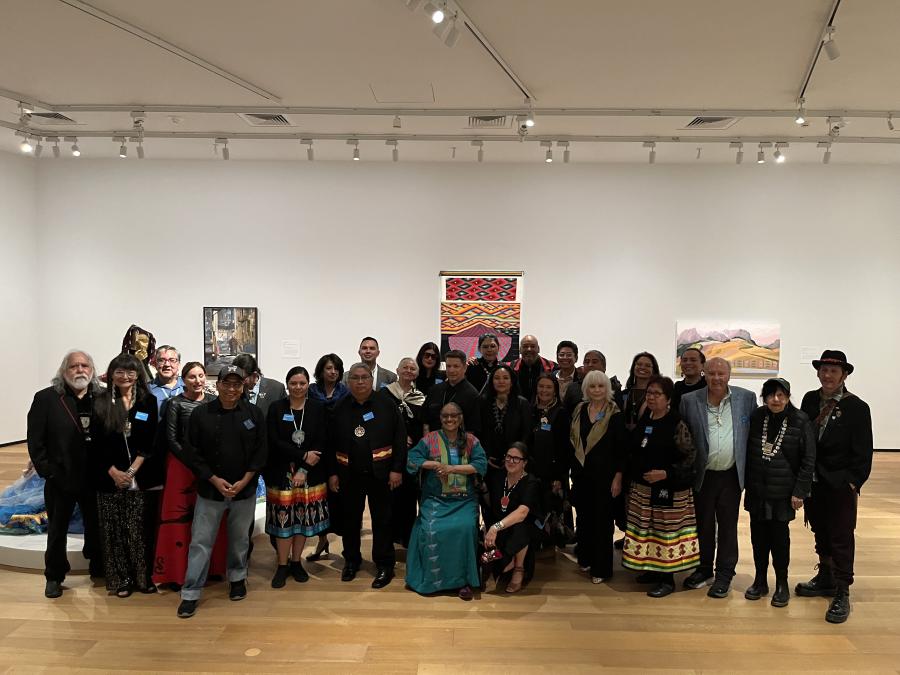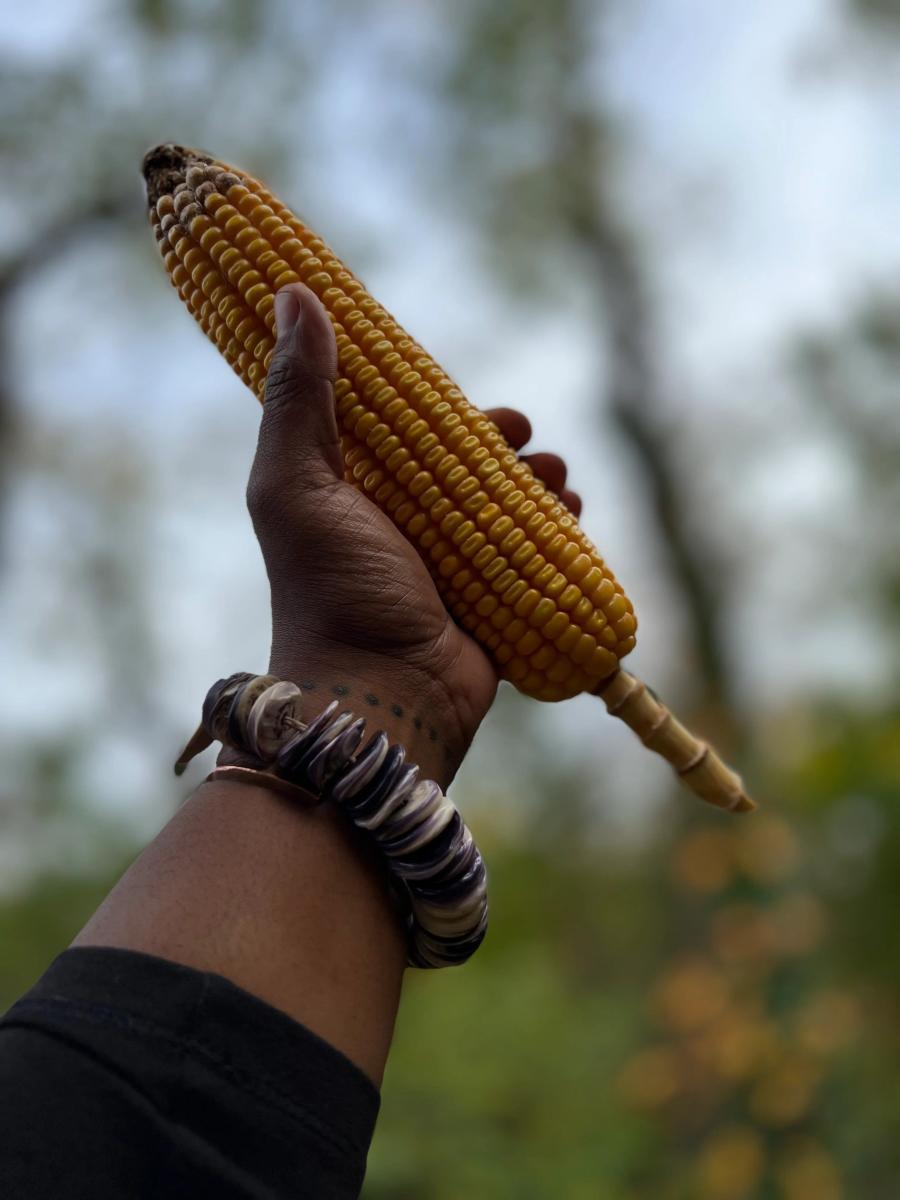
By Meg Holladay
The first school was built in Motahkomikuk, a Passamaquoddy community in northeastern Maine, in the late 1930s. St. Ann’s Indian Mission School, run by Catholic nuns, enrolled children from Motahkomikuk and nearby Sipayik, the two reservations where most Passamaquoddy live. The children, who spoke Passamaquoddy, came to school only to find that English was required. They were hit and hung on coat hooks by their collars for speaking the only language most of them knew. The pressures on Passamaquoddy students to assimilate, reinforced by the violent treatment that they suffered in school, would eventually cause English to replace Passamaquoddy as the communities’ daily language.
But in the last six years, many of those abused at the mission school (who are now grandparents) have begun to speak more Passamaquoddy. They once again sing childhood songs, are regaining vocabulary, and have begun to speak their language to their grandchildren. Young people are having more contact with the language. Tribal members living hundreds of miles from the reservations have started to hear Passamaquoddy in their homes again, and enthusiasm for the language is flourishing.
This change comes from several new projects. One, called Language Keepers, produced videos of groups conversing in Passamaquoddy. Another project was the completion of a bilingual dictionary after thirty years of work. In a third, native speakers are being audio-recorded for the online edition of the dictionary, pronouncing all 18,000 of its entries. And all these projects, cross-referenced, can be found on the Passamaquoddy-Maliseet Language Portal, a new website also created by Language Keepers.
The Passamaquoddy language is technically a dialect of Passamaquoddy-Maliseet, a language also spoken by the Maliseet people of northern Maine, New Brunswick and Québec. About 500 Passamaquoddy and 600 Maliseet—out of tribal populations of 3500 and 6000—speak the language fluently. Nearly all of them are over fifty years old. Passamaquoddy was common in the villages as late as the 1970s, but by 2006, it was most often used in short exchanges and within the family, on a limited range of topics. Many who had spoken it as children no longer could, and many adults who could speak it never did.
English had meanwhile become both more present and more useful. The Passamaquoddy lived a largely traditional life until the 1930s, when roads improved, the school opened, and contact with the outside world increased. In the 1950s, television and marriage to outsiders both became more common. Many also moved off the reservation to work, where they shifted to speaking English. And in 1980, so many of these workers returned home after an important land claims settlement that the population of the reservations doubled. Parents saw English as a language of social and economic opportunity and encouraged their children to speak it.
The abuse at school also continued until the 1960s or so, and those who had suffered it wanted to spare their children. They often spoke Passamaquoddy to them but had them reply in English. These children, who are parents today, grew up as only partial speakers of the language. Nearly all children today are monolingual in English, and like so many other Native American languages, Passamaquoddy is threatened.
But the elders did not intend or expect their native language to become endangered. Elder Allen Sockabasin writes that it is “the heart of our identity and the foundation of our spirituality.” It was simply so present to them that its loss didn’t seem like a possibility. When they realized it was, some of the speakers took action.
First, they finished the Passamaquoddy-Maliseet Dictionary. It was started in the 1970s by linguist Philip LeSourd, co-edited by native speaker David Francis and linguist Robert Leavitt, and finally published in 2008 by the University of Maine, with 18,500 entries. A searchable edition on the portal website continues to grow, although its size is already impressive: the comparable online Ojibwe People’s Dictionary has only 10,000 entries.
The dictionary was particularly challenging to create because of a linguistic property of Passamaquoddy. Like other languages of the Algonquian family, it is polysynthetic: as they talk, speakers create new words out of verb and noun roots that cannot stand on their own. For example, the English sentence “she washes her face,” of four separate words, is simply kossiqensu in Passamaquoddy. Students of Passamaquoddy must learn the rules for inserting new roots into frameworks they hear, so that hearing kossiqensu will show them how to say things like “she washes her knee” or “he washes her face.” No dictionary can include every possible Passamaquoddy word, but the dictionary editors had to include enough exemplary words to allow learners to figure out anything they encountered. Margaret Apt, a Passamaquoddy revitalizer, said that although the dictionary has only existed for six months in its present form, it has seen a lot of use. People “love the fact they can go into the portal themselves and look up a word without having to call someone and ask or go out in search of it.”
In 2006, the Passamaquoddy also began Language Keepers, in partnership with Ben Levine and Julia Schulz, with funding from the National Endowment for the Humanities Documenting Endangered Languages Program and the National Science Foundation. Levine and Schulz’s 2003 documentary Réveil: Waking Up French had focused on awakening French skills in former speakers from New England communities where the KKK had targeted the French. They had used a new reacquisition program that helped speakers work through their trauma. Passamaquoddy language leaders thought Levine and Schulz could help them, especially in addressing the loss of “public discourse,” conversations in the language outside the family. The Language Keepers project simply produced videos of fluent speakers having open-ended conversations. Among language revitalization projects, it may be unique.
Volunteer fluent speakers, or “facilitators,” convened groups of Passamaquoddy-speaking friends and guided them through the project. The groups talked for an hour or two at a time, only in Passamaquoddy but about anything they wanted, sometimes while doing things like picking berries or playing cards. All this was filmed, but speakers said they often forgot they were being recorded. Many conversations were held in places meaningful for the speakers, and these places prompted memories and sometimes language.
Then the groups gathered to watch their recorded conversations and choose interesting sections. These segments were subtitled in Passamaquoddy and English, and published on the portal and on learning DVDs. Now there are ninety-five videos, ranging from 15 seconds to 16 minutes long, in which speakers discuss porpoise-hunting and cranberry-picking, talk about spiritual experiences and tell childhood stories. In the online version, many subtitles include hyperlinks to the words’ dictionary entries, which, in turn, provide lists of other videos where the words occur. Levine hopes these cross-references will help people see how ideas relate in culturally specific ways, as when people trapping muskrats discuss first the animals themselves and then flagroot, a plant they eat, and its medicinal uses.
The videos are a priceless record of language and culture. For linguists, they model a new way to document language. In contrast to “elicitation,” in which linguists ask speakers questions to learn about a language, Language Keepers videos show how the language works in practice, and have provided many “new” words for the dictionary. They also document traditional Passamaquoddy culture—activities, like canoe-building, and views of the world, as when Grace Davis tells a group about the healing possesomuwinuwok, “star people,” that she finds in ocean water at night.
The video project has also begun to change the way some Passamaquoddy people feel about their language.
In one session, while playing cards, a speaker brought up St. Ann’s School. Out of this came nine videos in which the elders recall their abuse in horrifying detail, in the very language their teachers were attacking. When they spoke Passamaquoddy, which some nuns called “the language of the devil,” they were hit with rulers, erasers and switches, shut in the closet, and choked. Speakers found these large-group conversations deeply healing; Levine says they told him, “I feel better now.”
According to Levine, after oppression and years of living in English it was hard just to speak Passamaquoddy. People often started out speaking it, but switched to English when they couldn’t remember a word. The facilitators encouraged them to use English if they had to, but then to return to Passamaquoddy. Speakers talked for longer in the language than they had in years, remembered old words, and gained confidence. “Just the idea that the language was being used excited people,” said Deanna Francis, a facilitator. Some had thought that Passamaquoddy was a language of the past and could no longer describe the present, but they were pleased to find that they could gossip in it about who was getting married, praise their grandchildren’s interests, and complain about their children carrying snakes around.
Levine said the videos’ presence online has brought the language “back into visibility” and has sparked new positive associations. Speakers had often felt it was “a symbol of ignorance, backwardness and poverty,” or, more recently, had felt ashamed they hadn’t taught it to their children. But now, relatives see the videos online and call the speakers with congratulations. This gives them and the community, Levine said, new hope and encouragement about the language. Leavitt, the dictionary co-editor, said that the involvement of so many community members in the portal projects—around 100 for the dictionary and 60 for the videos—has contributed to people’s excitement.
And the project has sparked some new language use. Many partial speakers watch the videos to get the language “back into their systems.” Those living far from the reservations can now hear it in their homes anytime they want, and some say beginning to remember words and rhythms gives them “a whole new lease on life.” Teenagers watch the videos to get a sense of their Passamaquoddy identity. Younger children are excited about seeing relatives in the videos and are often hungry just to hear the language. Apt says that she feels “it is something the younger crowd has been wanting for a long time now,” and Language Keepers has awakened a dormant interest in what is “rightfully theirs.”
Another current project is the recording of native speakers pronouncing every word and example sentence in the dictionary. Many of the example sentences are funny, like speaker Wayne Newell’s creation for cokahk, an exclamation: Cokahk, motaqs, eluwehk-al-ote kulam: espons alokittis not! (Whoops, my dear, you were right after all: it is that dratted raccoon!). Passamaquoddy volunteers, often young adults, go to elders’ houses and read them words and phrases for them to pronouce, since many speakers are not literate in Passamaquoddy. The elders correct their pronunciations and have been cheered by the volunteers’ interest in the language. Donald Soctomah, the leader of the recording project, said that elders are now less resistant to speaking the language to young people.
And with this new confidence, many fluent speakers have begun to speak the language with children, often their grandchildren. Apt said, “While most young ones don't understand, I think that is changing. I know I am teaching my grandchildren because I am always speaking to them in Passamaquoddy and they understand and respond.” When spoken to cherished grandchildren, Levine observed, Passamaquoddy becomes a “language of love.”
The grant supporting Language Keepers recently expired, and the one that supports the dictionary audio-recording, from the Administration for Native Americans, will run out in September. Soctomah said the tribe has more plans, including an immersion program to pair partial speakers with older fluent speakers. Together, they would speak the language for hours a day, do activities from basket-weaving to grocery shopping, and learn to read and write Passamaquoddy. The activities and literacy, Soctomah said, would put the program “one step beyond” most master-apprentice language programs, and the language would get the younger fluent speakers it needs. But the tribe has no funding, and their grant proposal was recently rejected. Soctomah said they will fight for another grant.
Levine and Schulz, meanwhile, are working on revitalization projects for three more languages. The Mixe people of Oaxaca, Mexico, have asked them to teach them to be filmmakers so they can record and revitalize their language and way of life. The project is partnering with a plant geneticist studying Mixe corn, and the Mixe portal will include a way for Mixe migrant workers in the United States to communicate in videos with family at home in their native language during the decade or so many spend in the US. The other two programs are not yet funded, so their locations are secret.
With all this community creativity and hard work, the tide may be turning for Passamaquoddy. But although these projects have reinforced the use of the language, they have not yet created any new speakers. Only the next few years and projects will show whether another group of children will come to school speaking Passamaquoddy in years to come.
The Passamaquoddy-Maliseet Language Portal can be found at pmportal.org and the Speaking Place at speakingplace.org. Many thanks to Ben Levine, Donald Soctomah, Margaret Apt, and Robert Leavitt for interviews which made this article possible.


